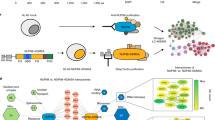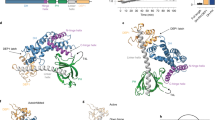Abstract
In acute promyelocytic leukemia (APL) the retinoic acid receptor alpha (RARα) becomes an oncogene through the fusion with several partners, mostly with promyelocytic leukemia protein (PML), all of which have in common the presence of a self-association domain. The new fusion proteins, therefore, differently from the wild-type RARα, which forms only heterodimers with retinoic X receptor alpha, are also able to homo-oligomerize. The presence of such a domain has been suggested to be crucial for the leukemogenic potential of the chimeric proteins found in APL blasts. Whether or not any self-association domain is sufficient to bestow a leukemogenic activity on RARα is still under investigation. In this work, we address this question using two different X-RARα chimeras, where X represents the coiled-coil domain of PML (CC-RARα) or the oligomerization portion of the yeast transcription factor GCN4 (GCN4–RARα). We demonstrate that in vitro both proteins have transforming potential, and recapitulate the main PML–RARα biological properties, but CC-RARα is uniquely able to disrupt PML nuclear bodies. Indeed, in vivo only the CC-RARα chimera induces efficiently APL in a murine transplantation model. Thus, the PML CC domain represents the minimal structural determinant indispensable to transform RARα into an oncogenic protein.
This is a preview of subscription content, access via your institution
Access options
Subscribe to this journal
Receive 12 print issues and online access
$259.00 per year
only $21.58 per issue
Buy this article
- Purchase on Springer Link
- Instant access to full article PDF
Prices may be subject to local taxes which are calculated during checkout





Similar content being viewed by others
References
Minucci S, Monestiroli S, Giavara S, Ronzoni S, Marchesi F, Insinga A et al. PML-RAR induces promyelocytic leukemias with high efficiency following retroviral gene transfer into purified murine hematopoietic progenitors. Blood 2002; 100: 2989–2995.
Warrell Jr RP, de The H, Wang ZY, Degos L . Acute promyelocytic leukemia. N Engl J Med 1993; 329: 177–189.
de The H, Lavau C, Marchio A, Chomienne C, Degos L, Dejean A . The PML-RAR alpha fusion mRNA generated by the t(15;17) translocation in acute promyelocytic leukemia encodes a functionally altered RAR. Cell 1991; 66: 675–684.
Kakizuka A, Miller Jr WH, Umesono K, Warrell Jr RP, Frankel SR, Murty VV et al. Chromosomal translocation t(15;17) in human acute promyelocytic leukemia fuses RAR alpha with a novel putative transcription factor, PML. Cell 1991; 66: 663–674.
Chen Z, Brand NJ, Chen A, Chen SJ, Tong JH, Wang ZY et al. Fusion between a novel Kruppel-like zinc finger gene and the retinoic acid receptor-alpha locus due to a variant t(11;17) translocation associated with acute promyelocytic leukaemia. EMBO J 1993; 12: 1161–1167.
Redner RL, Rush EA, Faas S, Rudert WA, Corey SJ . The t(5;17) variant of acute promyelocytic leukemia expresses a nucleophosmin-retinoic acid receptor fusion. Blood 1996; 87: 882–886.
Wells RA, Catzavelos C, Kamel-Reid S . Fusion of retinoic acid receptor alpha to NuMA, the nuclear mitotic apparatus protein, by a variant translocation in acute promyelocytic leukaemia. Nat Genet 1997; 17: 109–113.
Arnould C, Philippe C, Bourdon V, Gr goire MJ, Berger R, Jonveaux P . The signal transducer and activator of transcription STAT5b gene is a new partner of retinoic acid receptor alpha in acute promyelocytic-like leukaemia. Hum Mol Genet 1999; 8: 1741–1749.
Kamashev D, Vitoux D, De The H . PML-RARA-RXR oligomers mediate retinoid and rexinoid/cAMP cross-talk in acute promyelocytic leukemia cell differentiation. J Exp Med 2004; 199: 1163–1174.
Grignani F, De Matteis S, Nervi C, Tomassoni L, Gelmetti V, Cioce M et al. Fusion proteins of the retinoic acid receptor-alpha recruit histone deacetylase in promyelocytic leukaemia. Nature 1998; 391: 815–818.
Minucci S, Nervi C, Lo Coco F, Pelicci PG . Histone deacetylases: a common molecular target for differentiation treatment of acute myeloid leukemias? Oncogene 2001; 20: 3110–3115.
Carbone R, Botrugno OA, Ronzoni S, Insinga A, Di Croce L, Pelicci PG et al. Recruitment of the histone methyltransferase SUV39H1 and its role in the oncogenic properties of the leukemia-associated PML-retinoic acid receptor fusion protein. Mol Cell Biol 2006; 26: 1288–1296.
Di Croce L, Raker VA, Corsaro M, Fazi F, Fanelli M, Faretta M et al. Methyltransferase recruitment and DNA hypermethylation of target promoters by an oncogenic transcription factor. Science 2002; 295: 1079–1082.
Melnick A, Licht JD . Deconstructing a disease: RARalpha, its fusion partners, and their roles in the pathogenesis of acute promyelocytic leukemia. Blood 1999; 93: 3167–3215.
Kwok C, Zeisig BB, Dong S, So CW . Forced homo-oligomerization of RARalpha leads to transformation of primary hematopoietic cells. Cancer Cell 2006; 9: 95–108.
Sternsdorf T, Phan VT, Maunakea ML, Ocampo CB, Sohal J, Silletto A et al. Forced retinoic acid receptor alpha homodimers prime mice for APL-like leukemia. Cancer Cell 2006; 9: 81–94.
Zhou J, Peres L, Honore N, Nasr R, Zhu J, de The H . Dimerization-induced corepressor binding and relaxed DNA-binding specificity are critical for PML/RARA-induced immortalization. Proc Natl Acad Sci USA 2006; 103: 9238–9243.
Jensen K, Shiels C, Freemont PS . PML protein isoforms and the RBCC/TRIM motif. Oncogene 2001; 20: 7223–7233.
Grignani F, Gelmetti V, Fanelli M, Rogaia D, De Matteis S, Ferrara FF et al. Formation of PML/RAR alpha high molecular weight nuclear complexes through the PML coiled-coil region is essential for the PML/RAR alpha-mediated retinoic acid response. Oncogene 1999; 18: 6313–6321.
Minucci S, Maccarana M, Cioce M, De Luca P, Gelmetti V, Segalla S et al. Oligomerization of RAR and AML1 transcription factors as a novel mechanism of oncogenic activation. Mol Cell 2000; 5: 811–820.
Nervi C, Poindexter EC, Grignani F, Pandolfi PP, Lo Coco F, Avvisati G et al. Characterization of the PML-RAR alpha chimeric product of the acute promyelocytic leukemia-specific t(15;17) translocation. Cancer Res 1992; 52: 3687–3692.
Zeisig BB, Kwok C, Zelent A, Shankaranarayanan P, Gronemeyer H, Dong S et al. Recruitment of RXR by homotetrameric RARalpha fusion proteins is essential for transformation. Cancer Cell 2007; 12: 36–51.
Zhu J, Nasr R, Peres L, Riaucoux-Lormiere F, Honore N, Berthier C et al. RXR is an essential component of the oncogenic PML/RARA complex in vivo. Cancer Cell 2007; 12: 23–35.
Grignani F, Kinsella T, Mencarelli A, Valtieri M, Riganelli D, Lanfrancone L et al. High-efficiency gene transfer and selection of human hematopoietic progenitor cells with a hybrid EBV/retroviral vector expressing the green fluorescence protein. Cancer Res 1998; 58: 14–19.
Harbury PB, Zhang T, Kim PS, Alber T . A switch between two-, three-, and four-stranded coiled coils in GCN4 leucine zipper mutants. Science 1993; 262: 1401–1407.
Weissenhorn W, Calder LJ, Dessen A, Laue T, Skehel JJ, Wiley DC . Assembly of a rod-shaped chimera of a trimeric GCN4 zipper and the HIV-1 gp41 ectodomain expressed in Escherichia coli. Proc Natl Acad Sci USA 1997; 94: 6065–6069.
Grignani F, Testa U, Rogaia D, Ferrucci PF, Samoggia P, Pinto A et al. Effects on differentiation by the promyelocytic leukemia PML/RARalpha protein depend on the fusion of the PML protein dimerization and RARalpha DNA binding domains. EMBO J 1996; 15: 4949–4958.
Westervelt P, Lane AA, Pollock JL, Oldfather K, Holt MS, Zimonjic DB et al. High-penetrance mouse model of acute promyelocytic leukemia with very low levels of PML-RARalpha expression. Blood 2003; 102: 1857–1865.
Zhu J, Zhou J, Peres L, Riaucoux F, Honore N, Kogan S et al. A sumoylation site in PML/RARA is essential for leukemic transformation. Cancer Cell 2005; 7: 143–153.
Guibal FC, Alberich-Jorda M, Hirai H, Ebralidze A, Levantini E, Di Ruscio A et al. Identification of a myeloid committed progenitor as the cancer-initiating cell in acute promyelocytic leukemia. Blood 2009; 114: 5415–5425.
Wojiski S, Guibal FC, Kindler T, Lee BH, Jesneck JL, Fabian A et al. PML-RARalpha initiates leukemia by conferring properties of self-renewal to committed promyelocytic progenitors. Leukemia 2009; 23: 1462–1471.
Brown D, Kogan S, Lagasse E, Weissman I, Alcalay M, Pelicci PG et al. A PMLRARalpha transgene initiates murine acute promyelocytic leukemia. Proc Natl Acad Sci U S A 1997; 94: 2551–2556.
Grisolano JL, Wesselschmidt RL, Pelicci PG, Ley TJ . Altered myeloid development and acute leukemia in transgenic mice expressing PML-RAR alpha under control of cathepsin G regulatory sequences. Blood 1997; 89: 376–387.
Rego EM, Wang ZG, Peruzzi D, He LZ, Cordon-Cardo C, Pandolfi PP . Role of promyelocytic leukemia (PML) protein in tumor suppression. J Exp Med 2001; 193: 521–529.
Insinga A, Monestiroli S, Ronzoni S, Carbone R, Pearson M, Pruneri G et al. Impairment of p53 acetylation, stability and function by an oncogenic transcription factor. EMBO J 2004; 23: 1144–1154.
Ito K, Bernardi R, Morotti A, Matsuoka S, Saglio G, Ikeda Y et al. PML targeting eradicates quiescent leukaemia-initiating cells. Nature 2008; 453: 1072–1078.
Acknowledgements
We thank Massimo Stendardo, Manuela Capillo and the IFOM-IEO Campus mouse-service for the help with mice; tissue culture, sequencing, imaging and molecular pathology facilities for the technical assistance; Francesca Refaldi, Marco Sconfietti, Chiara Saccomanni and Anna Sciullo for cell sorting and FACS analysis; Sebastiano Pasqualato for SEC experiments. We thank Winfried Weissenhorn for the gift of the GCN4 encoding plasmid. We are grateful to Andrea Musacchio, Claudio Ciferri and Oronzina Botrugno for helpful discussions; Francesca De Franco, Roberto Dal Zuffo, Alessandra Marinelli, Virginia Giuliani, Sara Barozzi, and Mauro Romanenghi for technical support. Work in SM lab is supported by: AIRC, EEC (Epitron), Cariplo, MIUR, MiS.
Author information
Authors and Affiliations
Corresponding authors
Ethics declarations
Competing interests
The authors declare no conflict of interest.
Rights and permissions
About this article
Cite this article
Occhionorelli, M., Santoro, F., Pallavicini, I. et al. The self-association coiled-coil domain of PML is sufficient for the oncogenic conversion of the retinoic acid receptor (RAR) alpha. Leukemia 25, 814–820 (2011). https://doi.org/10.1038/leu.2011.18
Received:
Revised:
Accepted:
Published:
Issue Date:
DOI: https://doi.org/10.1038/leu.2011.18
Keywords
This article is cited by
-
B1 oligomerization regulates PML nuclear body biogenesis and leukemogenesis
Nature Communications (2019)
-
Acute Promyelocytic Leukemia: A History over 60 Years—From the Most Malignant to the most Curable Form of Acute Leukemia
Oncology and Therapy (2019)
-
Differentiation therapy revisited
Nature Reviews Cancer (2018)



